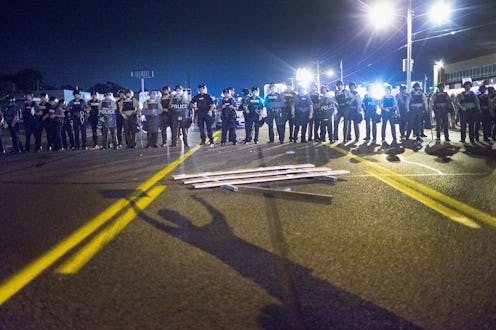News
This Difference Between Charlottesville & Ferguson Could Be Part Of A Sickening Double Standard

A white supremacist march in Charlottesville, Virginia, turned violent on Saturday, leaving one counter-protester dead and several others injured. The heavy law enforcement presence reminded people of the protest movement in Ferguson, Missouri several years earlier. However, as many people on Twitter noted, the police's response to the Charlottesville and Ferguson protests seemed very different.
The Ferguson protests erupted in 2014 as a response to the death of Michael Brown, an unarmed black teenager who was shot dead by police that year. According to The Washington Post, at least 155 people were arrested over the course of multiple demonstrations; although a handful of those arrests were for burglaries or assault, 124 people were arrested for "refusal to disperse." One unarmed protester was shot in the head by an unknown assailant; she survived, but the Ferguson Police Department has yet to make any arrests in the case.
Law enforcement was criticized for responding in what many saw as a militaristic manner to the unrest. The Justice Department opened an investigation into the FPD's response, and concluded in March 2015 that "Ferguson police officers routinely violate the Fourth Amendment in stopping people without reasonable suspicion, arresting them without probable cause, and using unreasonable force against them." On March 17, 2016, the city of Ferguson agreed to reform both the Ferguson Police Department and the city's Municipal Court.
The Charlottesville white supremacist rally began as a torch-wielding march at the University of Virginia campus, and it also drew a heavy police presence. Some of the attendees were heavily armed, and several pieces of footage from the event show counter-protesters being beaten by the white supremacists in attendance. Following the violence, the police response in Charlottesville is being heavily criticized for how it addressed the violence.
In total, at least 35 people were injured at the march, according to Charlottesville police chief Al Thomas. But in contrast to the 155 arrests that police made after the Ferguson protests, police arrested a mere four people after Charlottesville, according to Lynchburg, Virginia, station WSET.
"There was no police presence [during violent confrontations]," one counter-protester told The New York Times. "We were watching people punch each other; people were bleeding all the while police were inside of barricades at the park watching. It was essentially just brawling on the street and community members trying to protect each other."
Eventually, Virginia Gov. Terry McAuliffe declared a state of emergency, and police ordered the rally to disperse. However, while asked about the police's allegedly delayed response to the violence, Lt. Joseph Hatter of the Charlottesville Police told The Washington Post that it took action as soon as it could. "I don't know that we did wait," he said. "I think we did the best we could under the circumstances."
In a brief interview Sunday, Gov. McAuliffe also defended the police response in Virginia.
"You saw the militia walking down the street, you would have thought they were an army," McAuliffe said. "I was just talking to the State Police upstairs; [the milita] had better equipment than our State Police had. And yet not a shot was fired, zero property damage."
John Jay College Of Criminal Justice Professor Eugene O'Donnell had another theory as to why the police response wasn't as robust as many hoped it would be. "When people run amok and cause damage, people blame the police," O'Donnell told the Post. "When police act proactively, they get blamed for overreaching. People ask, 'Why weren't you more patient'?"
Still, BuzzFeed noted that the majority of people who attended the Ferguson protests were black, while the white supremacists who marched on Charlottesville were, well, white. Many suspected that this played a role in the difference in response from authorities.